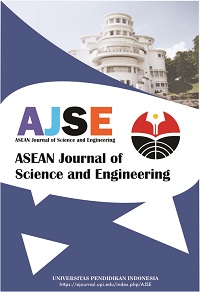Spatial-temporal and Factors Influencing the Distribution of Biodiversity: A Review
Abstract
Keywords
Full Text:
PDFReferences
Adon, M. P., Ouattara, A., and Gourene, G. (2011). Seasonal variation in the diversity and abundance of phytoplankton in a small African tropical reservoir. African Journal of Microbiology Research, 5(18), 2616–2626.
Ally, K. N., Richard, D. L., Emmanuel, M., John, B., Grayson, M., Maulid, M., and Robert, F. (2018). Spatial-temporal distribution, abundance, diversity and mortality of birds on road network in the Serengeti Ecosystem, Tanzania. International Journal of Biodiversity and Conservation, 10(4), 192–202.
Andersen, R. A. (1992). Diversity of eukaryotic algae. Biodiversity. Conserv, 1(4): 267–292.
Arrhenius, O. (1921). Species and area. Journal of Ecology, 9(1), 95-99.
Brown, J. H. (2014). Why are there so many species in the tropics? Journal of Biogeography, 41(1), 8–22.
Ceballos, G., García, A., and Ehrlich, P. R. (2010). The Sixth Extinction Crisis Loss of Animal Populations and Species. Journal of Cosmology, 8, 1821–1831.
Chang, C. C., and Turner, B. L. (2019). Ecological succession in a changing world. Journal of Ecology, 107(2), 503–509.
Chang, C., and HilleRisLambers, J. (2016). Integrating succession and community assembly perspectives. F1000Research, 5, 1–10.
Dengler, J. (2009). Which function describes the species-area relationship best? A review and empirical evaluation. Journal of Biogeography 36, 728-744.
Ding, Q., Shi, X., Zhuang, D., and Wang, Y. (2018). Temporal and spatial distributions of ecological vulnerability under the influence of natural and anthropogenic factors in an eco-province under construction in China. Sustainability, 10(9), 3087.
Freestone, A. L., Osman, R. W., Ruiz, G. M., and Torchin, M. E. (2011). Stronger predation in the tropics shapes species richness patterns in marine communities. Ecology, 92(4), 983–993.
Griffiths, V. F., Bull, J. W., Baker, J., and Milner-Gulland, E. J. (2019). No net loss for people and biodiversity. Conservation Biology, 33(1), 76–87.
Harrison, P. J., Buckland, S. T., Yuan, Y., Elston, D. A., Brewer, M. J., Johnston, A., and Pearce-Higgins, J. W. (2014). Assessing trends in biodiversity over space and time using the example of British breeding birds. Journal of Applied Ecology, 51(6), 1650–1660.
Inoue M., and Nunokawa M. (2002). Effects of longitudinal variations in stream habitat structure on fish abundance: an analysis based on subunit-scale classification. Freshwater Biology, 47, 1594– 1607.
Jansson, R., Rodríguez-Castañeda, G., and Harding, L. E. (2013). What can multiple phylogenies say about the latitudinal diversity gradient? A new look at the tropical conservatism, out of the tropics, and diversification rate hypotheses. Evolution, 67(6), 1741-1755.
K. Sharma, N., K. Rai, A., and Singh, S. (2006). Meteorological factors affecting the diversity of airborne algae in an urban atmosphere. Ecography, 29(5), 766-772.
Liu, S., Zhang, M., Zhao, Y., and Chen, N. (2021). Biodiversity and spatial-temporal dynamics of margalefidinium species in Jiaozhou bay, China. International Journal of Environmental Research and Public Health, 18(21), 11637.
Madhu, N. V., Jyothibabu, R., Balachandran, K. K., Honey, U. K., Martin, G. D., Vijay, J. G., Shiyas, C. A., Gupta, G. V. M., and Achuthankutty, C. T. (2007). Monsoonal impact on planktonic standing stock and abundance in a tropical estuary (Cochin backwaters - India). Estuarine, Coastal and Shelf Science, 73(1–2), 54–64.
Nelson, F. (2012). Natural conservationists? Evaluating the impact of pastoralist land use practices on Tanzania’s wildlife economy. Pastoralism, 2(1), 1–19.
Padisák, J., Tóth, L. G., and Rajczy, M. (1988). The role of storms in the summer succession of the phytoplankton community in a shallow lake (Lake Balaton, Hungary). Journal of Plankton Research, 10(2), 249–265.
Perry, J. N. A. M. Liebhold, M.S. Rosenberg, J. Dungan, M. Miriti, A. Jakomulska, S. Citron-Pousty. (2002). Illustrations and guidelines for selecting statistical methods for quantifying spatial pattern in ecological data. Ecography, 25(5), 578–600.
Prach, K., and Walker, L. R. (2019). Differences between primary and secondary plant succession among biomes of the world. Journal of Ecology, 107(2), 510–516.
Range, J. E., Harris, N. R., Johnson, D. E., George, M. R., and Mcdougald, N. K. (2002). The Effect of Topography, Vegetation, and Weather on Cattle Distribution at the San. Distribution, 8515, 53–63.
Renwick, A.R., Massimino, D., Newson, S.E., Chamberlain, D.E., Pearce-Higgins, J.W. and Johnston, A. (2012b) Modelling changes in species’ abundance in response to projected climate change. Diversity and Distributions, 18, 121–132.
Rosenzweig, M. L. (2010). Cambridge Books Online. Choice Reviews Online, 48(04), 1748-1788.
Santoul, F., Mengin, N., Céréghino, R., Figuerola, J., and Mastrorillo, S. (2005). Environmental factors influencing the regional distribution and local density of a small benthic fish: The stoneloach (Barbatula barbatula). Hydrobiologia, 544(1), 347–355.
Sarukhán, J., and Dirzo, R. (2013). Biodiversity-Rich Countries. Encyclopedia of Biodiversity: Second Edition, 1, 497–508.
Scheiner, S. M. (2003). Six types of species‐area curves. Global Ecology and Biogeography, 12(6), 441-447.
Sibly, R. M., Nabe-Nielsen, J., Forchhammer, M. C., Forbes, V. E., and Topping, C. J. (2009). The effects of spatial and temporal heterogeneity on the population dynamics of four animal species in a Danish landscape. BMC Ecology, 9(1), 1-9.
Sonter, L. J., Watson, K. B., Wood, S. A., and Ricketts, T. H. (2016). Spatial and temporal dynamics and value of nature-based recreation, estimated via social media. PLoS One, 11(9), 1–16.
Stoms, D. M., and Estes, J. E. (1993). Are remote sensing research agenda for mapping and monitoring biodiversity. International Journal of Remote Sensing, 14, 1839-1860.
Suding, K. N., and Hobbs, R. J. (2009). Threshold models in restoration and conservation: a developing framework. Trends in Ecology and Evolution, 24(5), 271–279.
Varga, D., Roigé, M., Pintó, J., and Saez, M. (2019). Assessing the spatial distribution of biodiversity in a changing temperature pattern: The case of Catalonia, Spain. International Journal of Environmental Research and Public Health, 16(20).
Walker, L. R. (2011). Integration of the study of natural and anthropogenic disturbances using severity gradients. Austral Ecology, 36(8), 916–922.
Walker, L. R., and Wardle, D. A. (2014). Plant succession as an integrator of contrasting ecological time scales. Trends in Ecology and Evolution, 29(9), 504–510.
White, E. P., Morgan Ernest, S. K., Adler, P. B., Hurlbert, A. H., and Kathleen Lyons, S. (2010). Integrating spatial and temporal approaches to understanding species richness. Philosophical Transactions of the Royal Society B: Biological Sciences, 365(1558), 3633–3643.
Yang, K., Yu, Z., Luo, Y., Zhou, X., and Shang, C. (2019). Spatial-temporal variation of lake surface water temperature and its driving factors in Yunnan-Guizhou plateau. Water Resources Research, 55(6), 4688–4703.
DOI: https://doi.org/10.17509/ajse.v2i3.42953
Refbacks
- There are currently no refbacks.
Copyright (c) 2022 Universitas Pendidikan Indonesia

This work is licensed under a Creative Commons Attribution-ShareAlike 4.0 International License.












